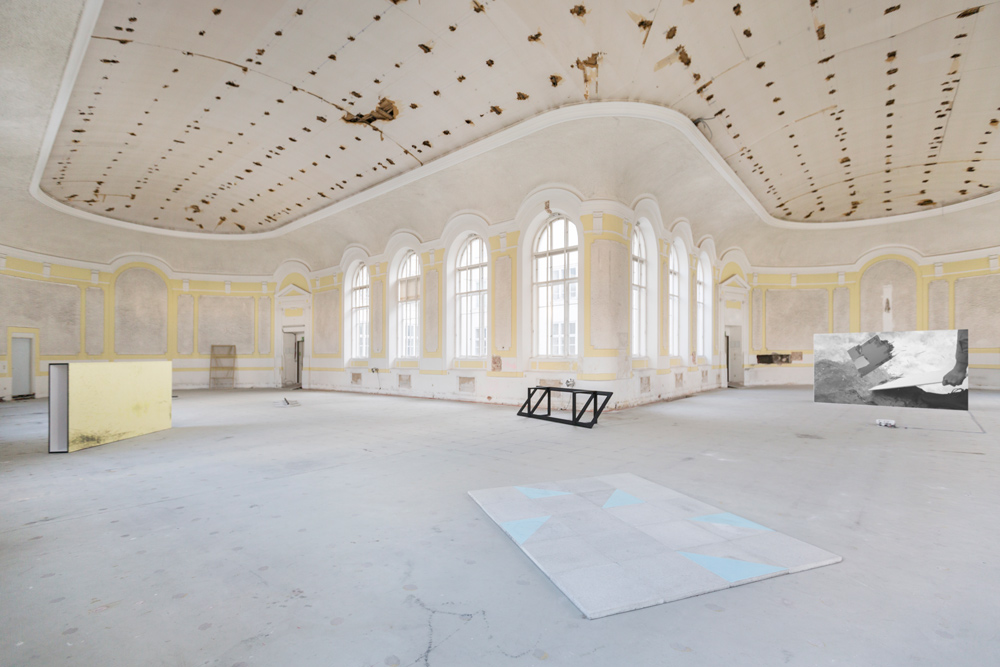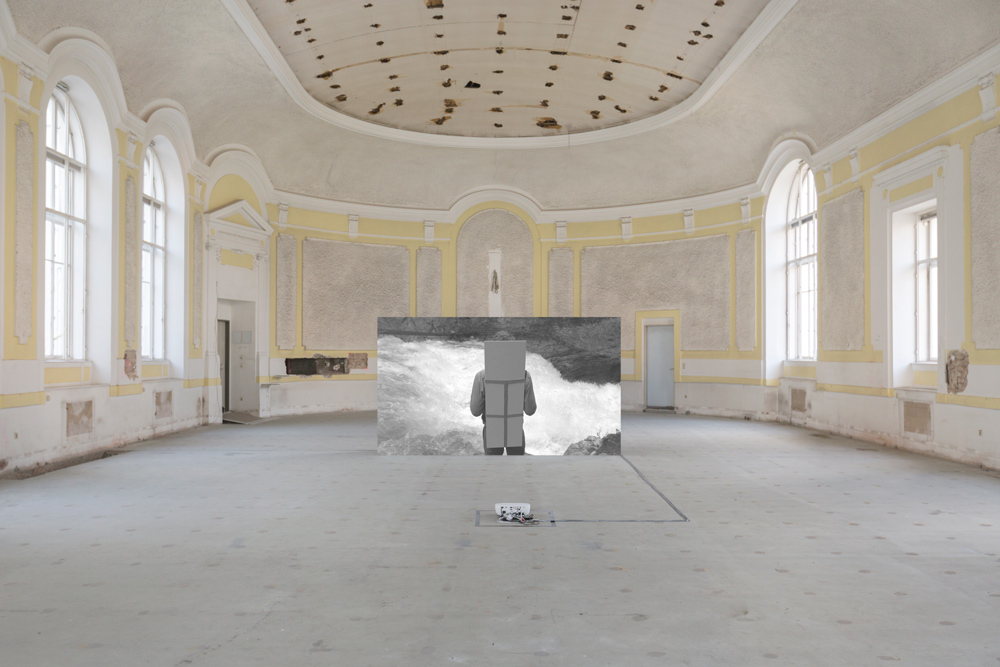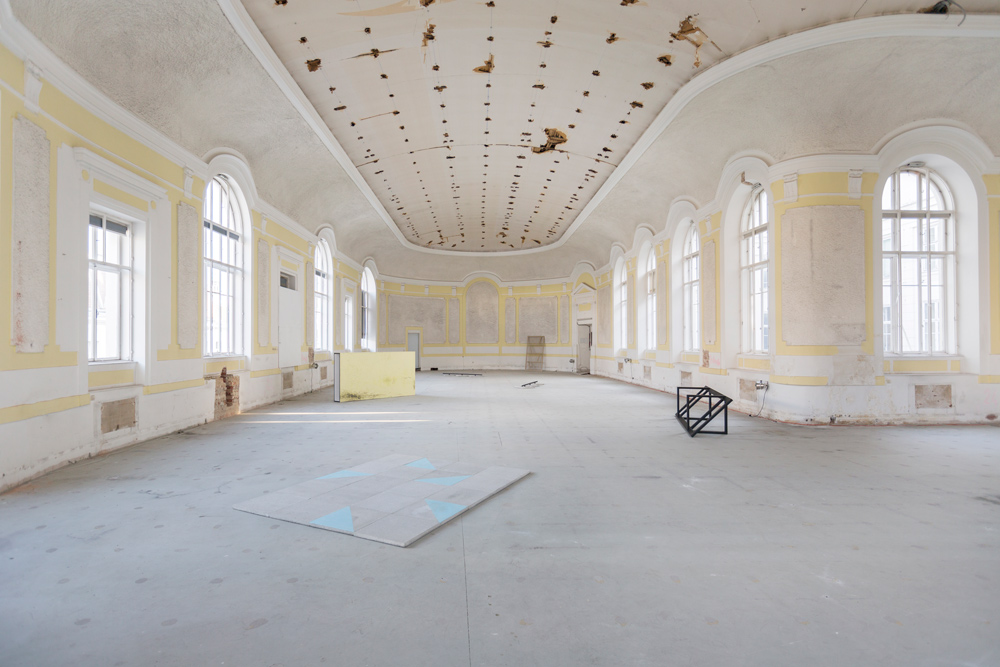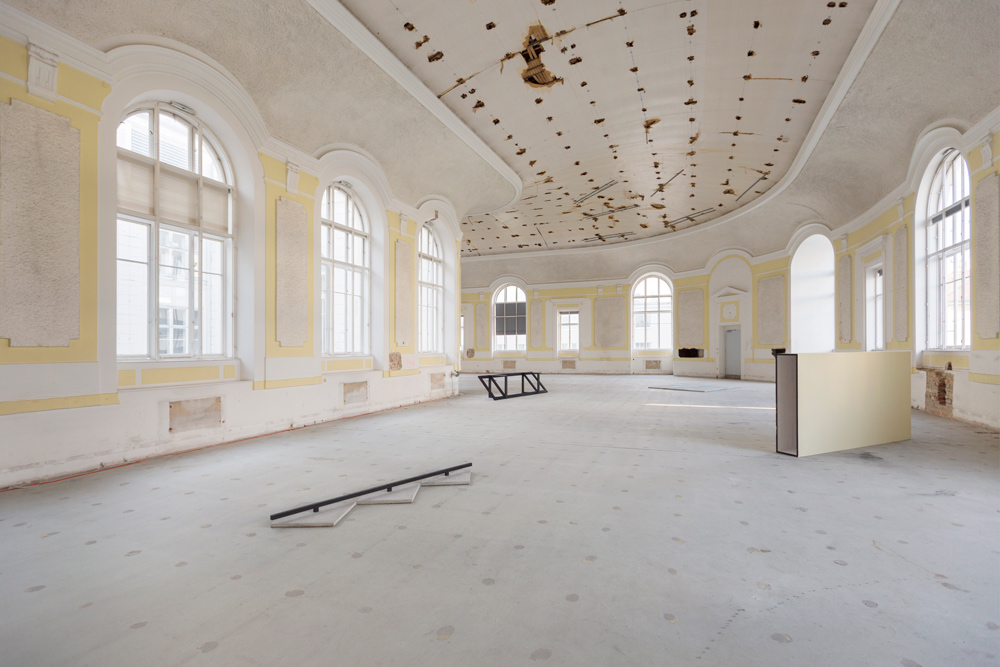




KAY WALKOWIAK. REQUIEM OF LOST FORMS
Ehemeliges K.K. Telegrafenamt, Vienna (AT)
21.06.2017 – 14.07.2017
Curator: Itai Margula (AT)
The exhibition series "Gestimmte Räume" understands space as a topos - and as a place that is played with. The works shown question the immutability of space, define its surroundings, create neighborhoods and, last but not least, change positional relationships. A conversation between space and objects. A conversation whose forms embed what is said in atmospheric backgrounds. In those atmospheres that Gernot Böhme calls tuned spaces.
Kay Walkowiak's exhibition at the K&K Telegraph Office focuses on two cinematic works: Requiem and Minimal Vandalism. Mozart's unfinished Requiem in D minor accompanies a hike through an idyllic mountain landscape. The visual language is reminiscent of early romantic paintings. The luggage includes a blank surface - a rectangle. An ecstatic gesture interrupts the wanderer's progression. The perfection of the geometric form meets the rough surface of nature.
The pitiful soundtrack to the hike is juxtaposed with the scratchy rhythm of the skateboarder in Minimal Vandalism. The dynamic choreography thwarts the clarity of the minimalist canon of forms and mercilessly leaves its traces. The spatial positioning of the two protagonists opens up a parcours through the scenic nature of space - a parcours through the Requiem of Lost Forms.
KW: The objects and films exhibited here all share the inherent elements of performance and participation. In the early days of Minimal Art, artists collaborated with dancers or with actors; they had their objects "performed". They were trying to fight the prevailing art paradigm. That's why they initially used snotty and provocative materials considered too unworthy to be part of a work of art. This was also a political gesture. Influenced by the writings of Maurice Merleau-Ponty and the phenomenologists, the body was placed at the center. With the increasing aestheticization of material surfaces - mirrors, highly polished metals, etc. - the objects returned to being, contrary to the original ideas, untouchable and almost sacrally charged. Here I draw a parallel with skateboard culture: in the beginning, young people would break into mansions in the summer and skate in their empty pools. Now, most major U.S. cities have skateparks that look like perfect minimal art installations. Only the different framing of the two spaces - the white cube, on the one hand, and the public outdoor space, on the other - results in completely different functions and perceptions. And today, you only need to wear a T-shirt of a skateboard brand to have social credibility. Something similar is happening in contemporary art production: if you use a minimalist vocabulary of forms, you are on the safe side. The initial meaning of the movement has fallen by the wayside. I make use of these mechanisms and exploit them. I produce forms that are respected even though they are a declination of something that had real relevance fifty years ago and has been commercialized today.
A performative situation allows me better to stimulate different senses. Why shouldn't we include all the senses that can potentially be addressed by a work of art? Children still want to grasp their environment with all their senses and, especially, through touching. We are socially conditioned to grasp the world intelligently. There is a body memory of usability, the intelligible anticipation of actual use. We immediately have a physical reference to a chair. I don't have to sit on every chair to know what phenomenological consequence that object holds for the body.
This space comes from a time of grand gestures. But it has aged and its shell is no longer fully intact; it is a wounded space. The surface of my objects are equally scratched and injured. Do the forms have now an increased added value because drawings have been created on the original smooth, clean surface by the skateboarder? The patina becomes an aura in which temporality and appreciation for the object resonate.
Text: Itai Margula, Vienna 2017
Photos: (c) Studio Kay Walkowiak
Kay Walkowiak's exhibition at the K&K Telegraph Office focuses on two cinematic works: Requiem and Minimal Vandalism. Mozart's unfinished Requiem in D minor accompanies a hike through an idyllic mountain landscape. The visual language is reminiscent of early romantic paintings. The luggage includes a blank surface - a rectangle. An ecstatic gesture interrupts the wanderer's progression. The perfection of the geometric form meets the rough surface of nature.
The pitiful soundtrack to the hike is juxtaposed with the scratchy rhythm of the skateboarder in Minimal Vandalism. The dynamic choreography thwarts the clarity of the minimalist canon of forms and mercilessly leaves its traces. The spatial positioning of the two protagonists opens up a parcours through the scenic nature of space - a parcours through the Requiem of Lost Forms.
KW: The objects and films exhibited here all share the inherent elements of performance and participation. In the early days of Minimal Art, artists collaborated with dancers or with actors; they had their objects "performed". They were trying to fight the prevailing art paradigm. That's why they initially used snotty and provocative materials considered too unworthy to be part of a work of art. This was also a political gesture. Influenced by the writings of Maurice Merleau-Ponty and the phenomenologists, the body was placed at the center. With the increasing aestheticization of material surfaces - mirrors, highly polished metals, etc. - the objects returned to being, contrary to the original ideas, untouchable and almost sacrally charged. Here I draw a parallel with skateboard culture: in the beginning, young people would break into mansions in the summer and skate in their empty pools. Now, most major U.S. cities have skateparks that look like perfect minimal art installations. Only the different framing of the two spaces - the white cube, on the one hand, and the public outdoor space, on the other - results in completely different functions and perceptions. And today, you only need to wear a T-shirt of a skateboard brand to have social credibility. Something similar is happening in contemporary art production: if you use a minimalist vocabulary of forms, you are on the safe side. The initial meaning of the movement has fallen by the wayside. I make use of these mechanisms and exploit them. I produce forms that are respected even though they are a declination of something that had real relevance fifty years ago and has been commercialized today.
A performative situation allows me better to stimulate different senses. Why shouldn't we include all the senses that can potentially be addressed by a work of art? Children still want to grasp their environment with all their senses and, especially, through touching. We are socially conditioned to grasp the world intelligently. There is a body memory of usability, the intelligible anticipation of actual use. We immediately have a physical reference to a chair. I don't have to sit on every chair to know what phenomenological consequence that object holds for the body.
This space comes from a time of grand gestures. But it has aged and its shell is no longer fully intact; it is a wounded space. The surface of my objects are equally scratched and injured. Do the forms have now an increased added value because drawings have been created on the original smooth, clean surface by the skateboarder? The patina becomes an aura in which temporality and appreciation for the object resonate.
Text: Itai Margula, Vienna 2017
Photos: (c) Studio Kay Walkowiak
︎ Archive Exhibitions